The Short – term training programme on “Spice Processing : Business Opportunities
and future Prospective” which is a part of the capacity building training programs on food
processing for SC-ST aspiring/ budding and existing Entrepreneurs under the aegis of national
SC-ST hub was held from 20 th January to 28 th January 2020 at CFTRI, Mysore. It was sponsored
by MSME. The training was coordinated by Dr. Ajay W. Tumaney and Dr. Aruna Kumar. There
were 29 numbers of people who participated in the training programme. Majority were from the
state itself and others were from different places like Telangana, Chattisgarh, Maharashtra and
Meghalaya. Participants from Meghalaya were five in number including four entrepreneurs and
one government official. They were sponsored from the scheme MIDH (Mission for Integrated
Development for Horticulture).
| SN | Participants | Gender | Contact No |
|---|---|---|---|
| * | Smti. (Dr.) Charis Kharkongor Ripnar | Female | 8787786016 |
| * | Shri. Antony Lyngdoh | Male | 6009437244 |
| * | Smti. Banisha Lyngdoh | Female | 8732852889 |
| * | Smti. Hambakla Rymbai | Female | 8132859384 |
| * | Smti. Odreena Gracia Shangpliang | Female | 9127383655 |

Spice processing trainees with the faculty members of CFTRI
First day: 20/01/2020
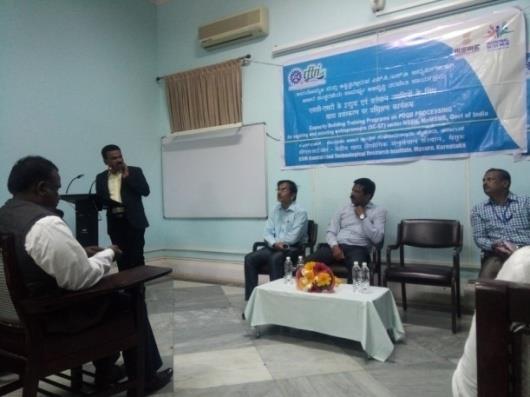
At the start of the training programme there was an inaugural session, briefing about the history of CFTRI. There was also the introduction about National SC-ST Hub by the NSSH official. The National SC/ST Hub is an initiative of the Government of India targeted towards developing a supportive ecosystem towards SC/ST entrepreneurs, Ministry of MSME, Government of India. The National SC/ST Hub has been set up to provide professional support to Scheduled Caste and Scheduled Tribe Entrepreneurs to fulfil the obligations under the Central Government Public Procurement Policy for Micro and Small Enterprises Order 2012, adopt applicable business practices and leverage the Stand-Up India initiative. The Hub would be implemented by the Ministry of MSME through National Small Industries Corporation (NSIC), a public-sector undertaking under the administrative control of Ministry of MSME. Then there was a lecture class on the role of CFTRI for Food Processing and was taken up by Dr. Ramesh Kumar, explaining about the importance of CFTRI in food processing and benefits it provided to the food industries. After this session there was a lecture class on processing of spices by Shri. M. Madhava Naidu. He gave information on the primary processing of spices which included harvesting and drying. Secondary processing would include quality control, fumigation and irradiation techniques. He also explained the different types of spices like pepper, ginger, turmeric, chillies.
In the afternoon session there was a demonstration on processing of fresh turmeric rhizomes. Washing, slicing and drying of turmeric were shown how it was carried out. One of our entrepreneurs enquired if boiling of turmeric was required or not, he replied that it was not needed since boiling would affect the colour of turmeric.
Second day: 21/01/2020
The first session of the day was a topic on “Sterilization of spices” that was explained by Shri. B.B. Borse. Sterilization processes like irradiation and fumigation processes exist for some seed and leafy spices, but are limited by cost, processing time and effect of treatment on flavour and colour of spices. “Spice oils and oleoresins” lecture was also given by Shri. Nagarajan. He explained on the production of spice oils by steam distillation which is a gentle process removing the oil by steam from ground spices at a temperature less than 100oC. The oleoresins represent the total flavouring components of spices in a very concentrated form. Spice oils give only the aroma of the spice, whereas, spice oleoresin represent the total flavour of the spice. They are prepared by extracting the ground spice with solvents like alcohol, acetone, hexane, methylene chloride, ethylene dichloride and ethyl acetate. However, pure solvents (food grade) should be used since they do not leave behind high boiling residues which affect the flavour adversely. Shri. Satyendra Rao gave a lecture on “Technology Transfer and Value Added Services by CFTRI” which was about the technology CFTRI offers in the post harvest handling, storage and processing of the food. Demonstration of processing on finger ginger was conducted by Shri. Madhava Naidu. There were three value added products of ginger that were prepared and they were ginger powder, ginger candy and ginger soda. For making of ginger powder, ginger was cleaned, sliced and dried for 8 hours at 50oC. Ginger was soaked in sugar syrup for 16 hours and removed. The sugar syrup was then added more sugar to increase the brix. It was repeated for 5 to 6 days to allow sugar to seep into the ginger and allowed to dry. Ginger soda was prepared from the remaining syrup prepared for ginger candy and it was mixed with soda.
Value added products of ginger
Third day: 22/01/2020
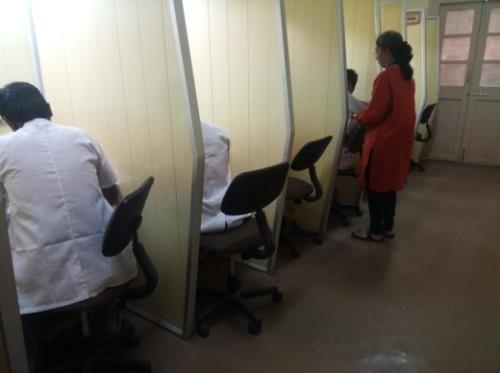 The lecture on “Spice powders and curry powders” was given on the third day by Shri. Madhava Naidu of Department of Spice and flavour science. Ground spices from chilli, turmeric, coriander, pepper and cumin have internal demand in India as pure powders. Some popular blends of India are garam masala, rasam powder, sambar powder, pav bhaji masala, panipuri masala, chat masala, biryani masala etc. A class on threshold test, scoville test, spice flavour profiling was conducted which explained about the sensory test on the food which is applicable to all food types. Sensory threshold is the weakest stimulus that an organism can detect. Similarly a person will test a food sample which has been added a flavour to the minimum level. Unless otherwise indicated, it is usually defined as the weakest stimulus that can be detected half the time. Scoville test is a measure of how pungent or spicy hot chili peppers.
The lecture on “Spice powders and curry powders” was given on the third day by Shri. Madhava Naidu of Department of Spice and flavour science. Ground spices from chilli, turmeric, coriander, pepper and cumin have internal demand in India as pure powders. Some popular blends of India are garam masala, rasam powder, sambar powder, pav bhaji masala, panipuri masala, chat masala, biryani masala etc. A class on threshold test, scoville test, spice flavour profiling was conducted which explained about the sensory test on the food which is applicable to all food types. Sensory threshold is the weakest stimulus that an organism can detect. Similarly a person will test a food sample which has been added a flavour to the minimum level. Unless otherwise indicated, it is usually defined as the weakest stimulus that can be detected half the time. Scoville test is a measure of how pungent or spicy hot chili peppers.
We had a demonstration on colour value in chilli and turmeric by using the European Oil Association method. Shri. Anil Kumar demonstrated the preliminary preparation of chilli solution and turmeric solution for estimating in the spectrophotometer. He explained little on how handling of the samples takes place. As long as the owner of the sample is not satisfied with the test results the samples cannot be discarded but must be kept till further notice.
Estimation of colour value of chilli
To calculate the colour value of turmeric, the powdery part must be removed in which the sediments that remain at the bottom of the flask will be taken for analysis. The sample has to be diluted and made up at standard volumetric flask. The reading in the spectrophotometer must be from 300-8000 lambda. Turmeric powder was heated in a steam distillation unit to remove the unwanted materials and collect the sediments called oleoresin to estimate the compounds present in it. It was left overnight and separated by a separating funnel. The filtrate was then made to 100ml volume in a volumetric flask. Little amount was taken, poured to a cuvette and put in a spectrophotometer for estimation of colour value. Drying of fenugreek leaves was also a part of the training session.
Processing of Fenugreek leaves
Forth day: 23/01/2020
The day started with a topic on “Quality, grading and specifications for spices” by Shri. Borse B.B. explaining the maintenance of quality of the spices. He briefed that the scheme of compulsory quality control and preshipment inspection scheme is operated by the Directorate of Marketing and Inspection, Ministry of Food and Agriculture, Government of India. Detailed specifications are laid down for each grade fixing limits for moisture content and immature produce, foreign matter, damaged produce like broken chillies, split cardamom capsules, etc. There are different Agmark’ grades for different spices. For example: Black pepper must have a very low limit of not more than 2- 3% of light berries is allowed. Moisture content is not allowed to exceed 11 to 12%. This prevents the formation of mould during transit. The next topic “Adulteration and contamination in spices and spice products” was taken up by Shri. M. A. Srinivas. Information on the procedure for detection of adulterants in the spices was given in detail. Shri. Aruna Kumar talked on the “Processed spice products-concepts of Indian Food laws, FSSAI requirements and labelling” which was about the laws regulating the safety and quality of food in India. In 1954, the Government of India enacted the Prevention of Food Adulteration Act and its rules in 1955 to implement a uniform Food Regulatory system. The Food Safety and Standards Act 2006 was enacted in the year 2011 to overcome the shortcomings and providing impetus to safety standards at par with international trade. Afternoon session was a demonstration on extraction on volatile oil by steam distillation. The method was carried out with a Cleavenger’s method. Raw material was clove for extraction of clove oil from it and the procedure was explained precisely.
Method of extraction of volatile oil
Fifth day: 24/01/2020
“Infestation control and fumigation in spices” was taken up by Shri. Ezhil Vendan which he talked about infestation control by fumigation in spices. It involves the application of chemicals in the gaseous phase that act against pest organisms. Currently, spice products are disinfested with phosphine or methyl bromide fumigants. Shri. Sathish H. S. explained on “Packaging aspects of spices and spices products” where functions of a package, packaging forms, packaging materials and future trends of packaging materials for spice were discussed. After the lunch break there was a demonstration on preparation of hygienic spice powders. Garam masala and rasam powder were shown how they were prepared.
Processing of spice powders (Garam masala and rasam powder)
Cryo-grinding of spices was also demonstrated where black pepper was taken for demonstration in. It was mixed with liquid nitrogen and transferred to a cryo-grinder. The powder obtained was found to be finely ground.
Cryo-grinding of pepper
Pepper mixed with liquid nitrogen
Sixth day: 25/01/2020
 We had an industrial visit at Agorsa Gourmet Pvt. Ltd. in Wayanad district, Kerela. This industry had adopted a technology from CFTRI and implemented in the processing unit. The person was Shri. Ebine Kariakose, Project Manager of the firm. The firm works on 95% automation. This industry manufactures ginger- garlic paste and tomato ketchup. He mentioned that he procures ginger from Wayanad, garlic from Rajasthan and tomato from Mysore. He explained the machines that were present in the processing unit.
We had an industrial visit at Agorsa Gourmet Pvt. Ltd. in Wayanad district, Kerela. This industry had adopted a technology from CFTRI and implemented in the processing unit. The person was Shri. Ebine Kariakose, Project Manager of the firm. The firm works on 95% automation. This industry manufactures ginger- garlic paste and tomato ketchup. He mentioned that he procures ginger from Wayanad, garlic from Rajasthan and tomato from Mysore. He explained the machines that were present in the processing unit.
Ginger peeling machine: Ginger peeling machine peels about 1 tonne of ginger per hour. With the blades rotating at 45O inclination the peel is removed from ginger. The disadvantage is that it is difficult to clean the parts of the machine. When asked how the mud is removed from the raw material, he said that mud could be removed in a bubble washer.
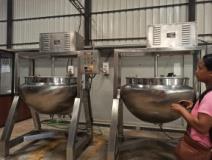 Garlic peeling machine: This machine can utilize 4500 kg of garlic. It peels one million of pieces in one hour. The bulbs are fed from the top surface. With air agitation taking place inside the peels will be removed. About 3kg comes out in every second.
Garlic peeling machine: This machine can utilize 4500 kg of garlic. It peels one million of pieces in one hour. The bulbs are fed from the top surface. With air agitation taking place inside the peels will be removed. About 3kg comes out in every second.
 Ginger-garlic paste maker: It produces 600kg of paste per hour. It works on 20 HP power. Moisture needs to be adjusted to get the required form of paste. Water is heated by electric boiler. The material of the equipment is made by stainless steel type.
Ginger-garlic paste maker: It produces 600kg of paste per hour. It works on 20 HP power. Moisture needs to be adjusted to get the required form of paste. Water is heated by electric boiler. The material of the equipment is made by stainless steel type.
Sachet packing machine: This machine can produce 30 packets per minute. It works on 15 HP power. The packing material is food graded polyester. Sachets are used only for a small quantity of product.
Filling machine: The glass packing machine is also available and it is considered to be better than the sachet since it does not affect the attributes of the product. For labelling, it is done manually by the workers in the unit.
Shri. Ebine also explained about the marketing of the products. The products are marketed in the southern parts till the central parts of the country. However, most of the products are transported and sold to the Middle East. It would take seven days to reach Dubai. It is easier to transport outside India than to the different parts of India due to the fact that no documentation charges are made when transported outside.
 The technology that was developed from CFTRI is the Hot break down tomato technology. The Enzyme pectin in tomato breaks down and the texture and colour changes. This gives a greater yield and a more viscous product and does not separate upon standing. When asked about the wastage obtained in production he mentioned that 40% of the product is lost. Although it was not an original technology developed by CFTRI, however, it was to adopt that technology few years back.
The technology that was developed from CFTRI is the Hot break down tomato technology. The Enzyme pectin in tomato breaks down and the texture and colour changes. This gives a greater yield and a more viscous product and does not separate upon standing. When asked about the wastage obtained in production he mentioned that 40% of the product is lost. Although it was not an original technology developed by CFTRI, however, it was to adopt that technology few years back.
Seventh-day: 27/01/2020
Shri. S.V.N Vijayendra talked on “Microbial contamination of spices and HACCP implementation for export of spices”. He discussed about the living and the non-living source of microbial contamination, the microbial species existing in spices and what methods are used to reduce the growth of microbes. The concept and principles of HACCP, types of physical hazards for spices, control of physical hazards and the scope, benefits and principles of HACCP was also discussed. The next lecture “Microbial techniques for isolation and identification of microbial contamination of spices” was given by Madam Pushpa S. Murthy in which she talked about the different test and techniques for detection of particular microbes in spices. Madam Pooja Rao explained on the “Encapsulation of spices and oleoresins”. Encapsulation is the technology of locking solids, liquids or gaseous material in minute, sealed capsules. She had mentioned the two major processes of encapsulation were spray drying and molten extrusion.
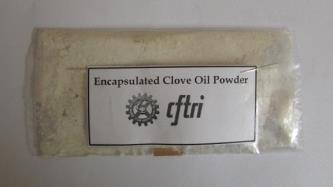
Encapsulated Clove oil Powder
Eight day: 28/01/2020
Valedictory session
There was a topic on setting up of an enterprise which was given by Shri. Raghavendra. He explained briefly on the method of setting consisting of plan, do check and action which are the important steps for setting up a processing industry. Few tips were also given on how the process could be done. Dr. G. K. Vidyashankar from Spice board scheme had explained the various schemes available for setting up the spice industry. To know more we can log on to the website of Spice Board of India i.e. www.indianspices.com. An official from NSIC had also also explained on registration in NSIC. He also advised that anybody can register online by going through Single Point Registration. One can also log on to www.scsthub.in for availing the schemes provided they fulfil the criteria as mentioned.
Valedictory Session: Trainees presenting a memento to the faculty members
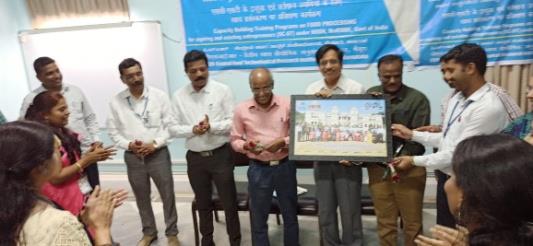
The trainees from Meghalaya
The trainees with the certificates
The valedictory and group discussion took place in the end and the co-ordinator Dr Ajay Tumaney declared the end of the training program with distribution of certificates to all the participants. The participants were also able to express what they felt about the training program.
Conclusion:
Taking the entrepreneurs for training has helped them by giving them exposures to new environment, activities and updated technologies which they can implement in their processing unit. They were able to observe different methods of processing using different machineries in making the work easier and faster. Entrepreneurs were also able to clear the doubts that they have in processing. However, when enquired about the equipments, the person in charge of the machines expressed that the equipments used in the institute were meant only for demonstration. The capacity, the power requirement of the equipment that need to be installed in the industry depends on the quantity of the raw material present. He clearly mentioned that we should know what type of design is required then we have to contact the dealer and ask him to design the machine according to our requirement. Overall evaluation on the entrepreneurs is that they were least able to understand the lecture part but were able to understand the practical session of the processing of the spices. Therefore, the training for them was beneficial.
Smti. (Dr.)Charis Kharkongor Ripnar
Technical Associate,
Directorate of Food Processing
Government of Meghalaya